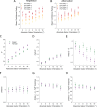History biases reveal novel dissociations between perceptual and metacognitive decision-making
- PMID: 37200046
- PMCID: PMC10207958
- DOI: 10.1167/jov.23.5.14
History biases reveal novel dissociations between perceptual and metacognitive decision-making
Abstract
Human decision-making and self-reflection often depend on context and internal biases. For instance, decisions are often influenced by preceding choices, regardless of their relevance. It remains unclear how choice history influences different levels of the decision-making hierarchy. We used analyses grounded in information and detection theories to estimate the relative strength of perceptual and metacognitive history biases and to investigate whether they emerge from common/unique mechanisms. Although both perception and metacognition tended to be biased toward previous responses, we observed novel dissociations that challenge normative theories of confidence. Different evidence levels often informed perceptual and metacognitive decisions within observers, and response history distinctly influenced first- (perceptual) and second- (metacognitive) order decision-parameters, with the metacognitive bias likely to be strongest and most prevalent in the general population. We propose that recent choices and subjective confidence represent heuristics, which inform first- and second-order decisions in the absence of more relevant evidence.
Figures






Similar articles
-
Adaptive History Biases Result from Confidence-Weighted Accumulation of past Choices.J Neurosci. 2018 Mar 7;38(10):2418-2429. doi: 10.1523/JNEUROSCI.2189-17.2017. Epub 2018 Jan 25. J Neurosci. 2018. PMID: 29371318 Free PMC article.
-
Sure I'm Sure: Prefrontal Oscillations Support Metacognitive Monitoring of Decision Making.J Neurosci. 2017 Jan 25;37(4):781-789. doi: 10.1523/JNEUROSCI.1612-16.2016. J Neurosci. 2017. PMID: 28123015 Free PMC article.
-
Global visual confidence.Psychon Bull Rev. 2021 Aug;28(4):1233-1242. doi: 10.3758/s13423-020-01869-7. Epub 2021 Mar 25. Psychon Bull Rev. 2021. PMID: 33768504 Free PMC article.
-
Optimal metacognitive decision strategies in signal detection theory.Psychon Bull Rev. 2025 Jun;32(3):1041-1069. doi: 10.3758/s13423-024-02510-7. Epub 2024 Nov 18. Psychon Bull Rev. 2025. PMID: 39557811 Free PMC article. Review.
-
The role of metacognitive feelings in motivation.Behav Brain Sci. 2025 Jan 31;48:e40. doi: 10.1017/S0140525X24000359. Behav Brain Sci. 2025. PMID: 39886883 Review.
Cited by
-
Information search under uncertainty across transdiagnostic psychopathology and healthy ageing.Transl Psychiatry. 2024 Sep 3;14(1):353. doi: 10.1038/s41398-024-03065-w. Transl Psychiatry. 2024. PMID: 39227371 Free PMC article.
-
Robust spatial ventriloquism effect and trial-by-trial aftereffect under memory interference.Sci Rep. 2020 Nov 30;10(1):20826. doi: 10.1038/s41598-020-77730-7. Sci Rep. 2020. PMID: 33257687 Free PMC article.
-
Online self-evaluation of fMRI-based neurofeedback performance.Philos Trans R Soc Lond B Biol Sci. 2024 Dec 2;379(1915):20230089. doi: 10.1098/rstb.2023.0089. Epub 2024 Oct 21. Philos Trans R Soc Lond B Biol Sci. 2024. PMID: 39428884 Free PMC article.
-
Action information contributes to metacognitive decision-making.Sci Rep. 2020 Feb 27;10(1):3632. doi: 10.1038/s41598-020-60382-y. Sci Rep. 2020. PMID: 32107455 Free PMC article.
-
Psychiatrically relevant signatures of domain-general decision-making and metacognition in the general population.Npj Ment Health Res. 2022 Aug 30;1(1):10. doi: 10.1038/s44184-022-00009-4. Npj Ment Health Res. 2022. PMID: 38609460 Free PMC article.
References
-
- Adler, W. T., & Ma, W. J. (2018). Limitations of proposed signatures of Bayesian confidence. Neural computation , 30(12), 3327–3354. - PubMed
-
- Ais, J., Zylberberg, A., Barttfeld, P., & Sigman, M. (2016). Individual consistency in the accuracy and distribution of confidence judgments. Cognition, 146, 377–386. - PubMed
-
- Akaishi, R., Umeda, K., Nagase, A., & Sakai, K. (2014). Autonomous mechanism of internal choice estimate underlies decision inertia. Neuron, 81(1), 195–206. - PubMed
-
- Allefeld, C., Görgen, K., & Haynes, J. D. (2016). Valid population inference for information-based imaging: From the second-level t-test to prevalence inference. Neuroimage, 141, 378–392. - PubMed
Publication types
MeSH terms
Grants and funding
LinkOut - more resources
Full Text Sources

